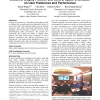Free Online Productivity Tools
i2Speak
i2Symbol
i2OCR
iTex2Img
iWeb2Print
iWeb2Shot
i2Type
iPdf2Split
iPdf2Merge
i2Bopomofo
i2Arabic
i2Style
i2Image
i2PDF
iLatex2Rtf
Sci2ools
CHI
2006
ACM
2006
ACM
Effects of display position and control space orientation on user preference and performance
In many environments, it is often the case that input is made to displays that are positioned non-traditionally relative to one or more users. This typically requires users to perform interaction tasks under transformed input-display spatial mappings, and the literature is unclear as to how such transformations affect performance. We present two experiments that explore the impact of display space position and input control space orientation on user's subjective preference and objective performance in a docking task. Our results provide guidelines as to optimal display placement and control orientation in collaborative computing environments with one or more shared displays. Author Keywords Input-output mappings, spatial transformation, performance ACM Classification Keywords H.5.2 [User Interfaces]: Interaction styles
CHI 2006 | Control Space Orientation | Human Computer Interaction | Input-display Spatial Mappings | Keywords Input-output Mappings |
| Added | 30 Nov 2009 |
| Updated | 30 Nov 2009 |
| Type | Conference |
| Year | 2006 |
| Where | CHI |
| Authors | Daniel Wigdor, Chia Shen, Clifton Forlines, Ravin Balakrishnan |
Comments (0)

